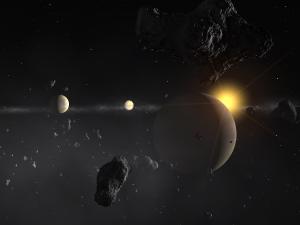Blog
Life in the Clouds
25 June 2021
 NASA Ames/JPL-Caltech/T. Pyle
NASA Ames/JPL-Caltech/T. PyleEarth is perfectly suited for organic life. It stands to reason then that similar worlds orbiting distant stars might also be rich with life. But proving it will be a challenge. One of the better ways to discover extraterrestrial life will be to study the atmospheres of inhabited exoplanets, but Earth is fairly small for a planet and has a thin atmosphere compared to larger worlds. It will be much easier to study the atmospheres of gas planets, but could such worlds harbor life? A new paper in Universe argues it could.1
Exobiologists have long argued that we shouldn’t assume all life in the universe will be on planets similar to Earth. The subsurface oceans of Enceladus and Ganymede could support terrestrial life and Titan has a rich methane chemistry that might support exotic life. But most ideas about life require three main ingredients: energy, water, and a surface.
The first two are pretty obvious. Life needs some kind of energy source to survive, whether it be solar or geothermal, and water is the perfect solution to allow complex molecules to interact. But the requirement of a surface is more subtle. It isn’t needed for life to survive, since lots of organisms can spend their entire life in water or air. Instead, it seems to be necessary for life to arise. Surface chemistry is incredibly good at creating large organic molecules, even in space. It likely takes a rocky surface to create the building blocks of life.
 NASA/Ken Hodges
NASA/Ken HodgesThis new paper argues that while surface chemistry might be needed for life to arise in a planetary system, it isn’t needed for life to thrive. The work focuses on warm sub-Neptune worlds. These planets are about 8 - 10 times more massive than Earth and are likely small gas planets with a thick atmosphere but no terrestrial surface. Several of these worlds have been found in the potentially habitable zone of their star, such as K2-18b, which closely orbits a red dwarf star.
The team shows that warm sub-Neptunes such as K2-18b likely have plenty of water and organic molecules needed to create a habitable zone within their atmosphere. And being smaller gas worlds, it is likely that the habitable layer is fairly stable, allowing for any life to remain aloft long enough to reproduce before sinking to the hostile depths below. Similar arguments have been made for the potentially habitable layer of Venus’s atmosphere. But unlike Venus, K2-18b isn’t likely to have a surface. So even though life might survive on a sub-Neptune world, how would it get there?
 ESO
ESOHere the team argues that asteroids might come to the rescue. If an exoplanetary system has an unstable asteroid belt, meteorite impacts with the sub-Neptune planet and smaller terrestrial worlds would both be common. This cross-pollination could bring life to a gassy world.
Because sub-Neptunes are fairly common and have thick atmospheres, they will be among the first planets we study for signs of life. While the odds of finding life on these worlds might be a bit long, it’s worth taking a look just because we can.
Seager, Sara, et al. “Possibilities for an Aerial Biosphere in Temperate Sub Neptune-Sized Exoplanet Atmospheres.” Universe 7.6 (2021): 172. ↩︎